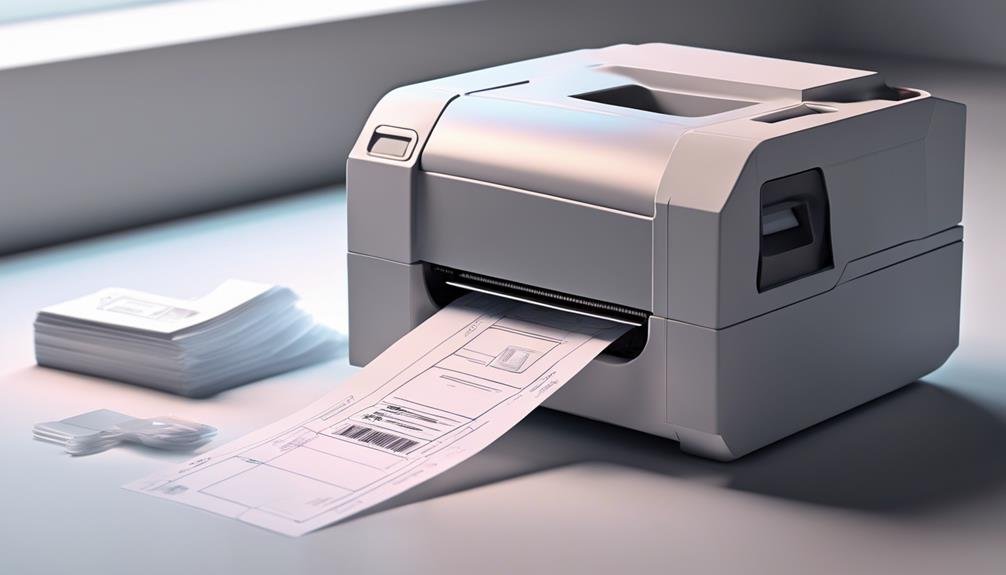You've likely stumbled upon thermal printers, which use advanced technology to produce high-quality images without relying on ink or toner. Thermal printers work by selectively heating paper to produce images, making them a cost-effective and environmentally friendly alternative. With thermal printing, you'll reduce waste from discarded ink cartridges, and enjoy prints that are resistant to smudging, fading, and water damage. From point-of-sale systems to healthcare and food service industries, thermal printers are widely used for high-volume printing with fast and reliable output. As you investigate thermal printers further, you'll uncover even more benefits and applications for this groundbreaking technology.
How Thermal Printers Work
When you use a thermal printer, advanced technology takes center stage, as it's the catalyst that produces the images on the paper. This cutting-edge technology allows thermal printers to create images without the need for ink or toner.
So, how do they work? The print head in a thermal printer selectively heats up the paper to produce text, graphics, or barcodes. In direct thermal printers, the heat activates heat-sensitive chemicals on the paper, producing the desired image. On the other hand, thermal transfer printers use a heated ribbon to transfer ink onto the paper, resulting in more durable prints.
Thermal printers are commonly used in point-of-sale systems, shipping labels, and medical devices due to their simplicity and reliability. The process is straightforward: the print head heats up the paper, and the image appears. With thermal printers, you don't need to worry about running out of ink or replacing toner cartridges.
These printers are designed for high-volume printing and can produce crisp, high-quality images quickly and efficiently. Whether you need to print receipts, labels, or barcodes, thermal printers are an excellent choice.
Benefits of Inkless Printing
By eliminating the need for ink cartridges, you'll reap significant benefits from inkless printing technology, including reduced waste, lower costs, and more durable prints. With inkless printing, you can say goodbye to the hassle of constantly replacing ink cartridges and the environmental impact that comes with it. Not only will you reduce waste, but you'll also save money in the long run.
Here's a breakdown of the benefits you can expect from inkless printing:
| Benefit | Description |
|---|---|
| Reduced Waste | No more discarded ink cartridges or wasted ink |
| Cost-Effective | No need to constantly purchase new ink cartridges |
| Durable Prints | Prints are resistant to smudging, fading, and water damage |
| Environmental Benefits | Reduces environmental impact by minimizing waste and pollution |
Inkless printing technology uses heat, pressure, or chemical processes to create images without traditional ink, making it a game-changer for those looking to reduce their environmental footprint. With its cost-effective and durable prints, inkless printing is an attractive option for those looking to make a switch.
Thermal Printer Applications

You'll find thermal printers in a variety of applications, from printing point-of-sale receipts to creating shipping labels and barcode prints. These versatile printers are commonly used in retail environments, where they quickly produce receipts, invoices, and other documents.
Thermal printers are also widely used in logistics and shipping operations, where they help generate shipping labels, barcodes, and other identification labels. Additionally, thermal printing is used in healthcare, where it's crucial for printing labels for patient records, lab samples, and medication labels.
Additionally, thermal printers are used in food service industries, where they produce labels for food packaging and inventory management. The speed and reliability of thermal printers make them an ideal choice for these applications, where downtime can be costly. With their ability to produce high-quality prints at fast speeds, thermal printers have become a vital tool in many industries.
Cost-Effective Printing Solution
As you investigate options to thermal printers, you'll find that toner-based laser printers offer a cost-effective printing solution that can greatly reduce your printing expenses.
By using toner powder instead of ink cartridges, laser printers provide a more affordable option for high-volume printing. The cost per page of toner cartridges is notably lower compared to inkjet printer ink cartridges, making them an ideal choice for businesses with regular printing needs.
Although the initial investment in a laser printer may be higher, the long-term savings from lower-cost toner refills will quickly add up. Moreover, laser printers are known for their efficiency and long-lasting toner, reducing the need for frequent replacements. This makes them a preferred choice for black-and-white document printing, especially for businesses that require high-quality output.
Environmental Impact of Thermal

Thermal printers, which don't use ink, greatly reduce waste and environmental impact since they don't generate hazardous ink cartridges that need to be disposed of. As you consider using a thermal printer, you'll find that they produce minimal waste, making them an attractive option for environmentally conscious individuals and businesses.
Since thermal printers rely on thermal printing technology that heats special paper to create images, you won't have to worry about disposing of used ink cartridges or dealing with the environmental consequences of manufacturing new ones. The thermal paper used in these printers is coated with a special chemical that changes color when exposed to heat, eliminating the need for ink refills. This energy-efficient printing method not only reduces waste but also produces clear, smudge-free prints.
Thermal Vs Traditional Printers
When comparing thermal printers to traditional printers, it's important to understand the fundamental differences in their printing technologies. You might be wondering what sets them apart. The answer lies in how they produce images and text on paper. Traditional printers, like inkjet printers, rely on ink or toner to create prints, whereas thermal printers use heat to print on special thermal paper, eliminating the need for ink or toner cartridges.
Here are some key distinctions to keep in mind:
- Printing Technology: Thermal printers use heat, while traditional printers use ink or toner.
- Cost-Effectiveness: Thermal printers are more economical for specific applications, such as printing receipts and barcode labels.
- Print Quality: Traditional printers offer more versatility in terms of color and print quality, while thermal printers excel in speed and simplicity.
- Application: Thermal printers are ideal for high-volume, black-and-white printing tasks, while traditional printers are better suited for color printing and high-quality images.
Common Uses for Thermal Printers

What kinds of environments and industries typically rely on thermal printers to get the job done efficiently?
You'll often find thermal printers in point-of-sale systems, healthcare facilities, and shipping companies, where speed and reliability are vital. These industries require printers that can produce high-quality labels, receipts, and tickets quickly and efficiently, without the hassle of ink or toner replacements.
Thermal printers, like Canon PIXMA, fit the bill perfectly, offering fast printing speeds and low maintenance requirements. In healthcare, thermal printers are used to print patient labels, lab results, and medication labels. In shipping, they're used to print shipping labels, barcodes, and receipts.
With their ability to produce high-quality prints quickly and efficiently, thermal printers have become a critical tool in these industries. Unlike traditional printers, thermal printers use direct thermal or thermal transfer methods to produce images, making them ideal for applications where speed and reliability are paramount.
Frequently Asked Questions
What Kind of Printer Doesn't Use Ink?
You're wondering what kind of printer doesn't use ink? Well, it's the one that utilizes laser technology, where static electricity transfers toner powder onto a drum, producing high-quality prints without a single drop of ink.
Are Inkless Printers Good?
You're wondering if inkless printers are good, and the answer is yes! They're an eco-friendly alternative, reducing waste and environmental impact by eliminating the need for ink cartridges, making them a great choice for the planet-conscious user.
Is There Such Thing as a Printer Without Ink?
You're wondering if there's a printer that doesn't use ink, and the answer is yes! Eco-friendly alternatives exist, using toner powder or other creative methods that reduce waste and minimize environmental impact.
Does an Inkless Printer Exist?
You're curious if an inkless printer exists, and the answer is, not exactly. However, eco-friendly alternatives like thermal printers and UV printers offer creative solutions that reduce reliance on traditional ink, aligning with your eco-conscious values.
Conclusion
As you discover the world of printing, you'll find that thermal printers offer a unique advantage. By using heat to produce images, they eliminate the need for ink, making them a cost-effective and environmentally friendly option.
With their high-speed capabilities and durability, thermal printers have become crucial in different industries. Whether you're looking to streamline your labeling process or create scannable barcodes, thermal printers provide a reliable and efficient solution, making them an attractive alternative to traditional printing methods.